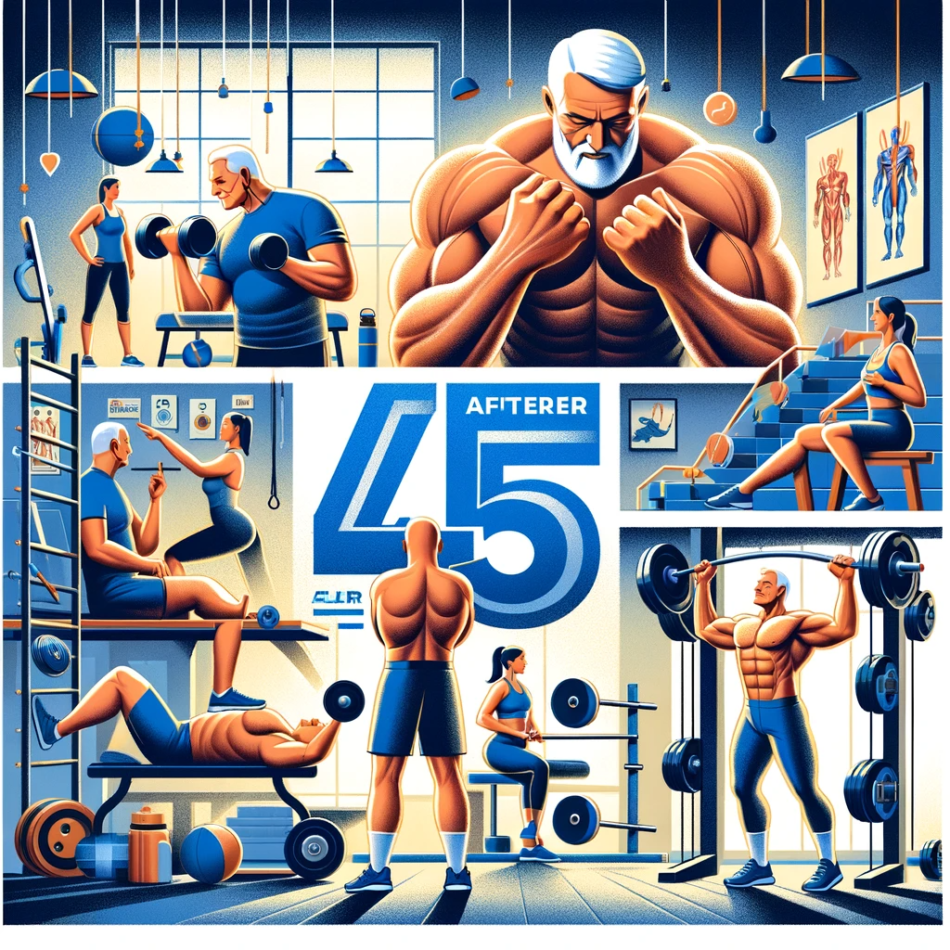Aging is an inevitable part of life, and as we approach our 40s and beyond, we often start to notice changes in our bodies. One of the most significant changes is the gradual loss of muscle mass and strength. This natural process, known as sarcopenia, can lead to various health issues and a decline in overall quality of life. However, the good news is that it’s possible to counteract this muscle loss and even build and maintain muscle mass well into your later years. In this comprehensive article, we will explore the importance of muscle mass, the factors contributing to muscle loss, and practical strategies to build and maintain muscle after the age of 45.
The Importance of Muscle Mass
Muscles are not just about aesthetics or physical strength; they play a crucial role in overall health and well-being, especially as we age. Here are some key reasons why muscle mass matters:
1. Metabolism and Weight Management:
- Muscle tissue burns more calories at rest than fat tissue. By increasing muscle mass, you can boost your resting metabolic rate, making it easier to manage your weight and prevent weight gain.
2. Bone Health:
- Strong muscles support healthy bones. Regular strength training can help reduce the risk of osteoporosis and fractures, which become more common with age.
3. Functional Independence:
- Muscles are essential for daily activities like lifting groceries, climbing stairs, and getting in and out of chairs. Maintaining muscle mass helps you stay independent and functional.
4. Chronic Disease Prevention:
- Regular physical activity and muscle-building exercises are associated with a reduced risk of chronic conditions such as type 2 diabetes, heart disease, and hypertension.
5. Joint Health:
- Strong muscles provide stability to joints, reducing the risk of injury and the progression of conditions like arthritis.
6. Balance and Fall Prevention:
- Muscle strength contributes to balance and coordination, which are critical for preventing falls, a common concern for older adults.
Factors Contributing to Muscle Loss After 45
Several factors contribute to the loss of muscle mass as we age. Understanding these factors can help us develop effective strategies to counteract them:
1. Hormonal Changes:
- Declining levels of hormones such as testosterone and growth hormone can lead to reduced muscle protein synthesis and muscle loss.
2. Physical Inactivity:
- A sedentary lifestyle or reduced physical activity can accelerate muscle loss.
3. Dietary Habits:
- Poor nutrition, including inadequate protein intake, can hinder muscle maintenance and growth.
4. Chronic Illness:
- Chronic diseases like diabetes and kidney disease can contribute to muscle wasting.
5. Inflammation:
- Chronic inflammation, often associated with aging, can lead to muscle protein breakdown.
6. Medications:
- Some medications have side effects that can impact muscle mass and strength.
7. Nutrient Absorption:
- Age-related changes in nutrient absorption can affect the availability of essential nutrients for muscle health.
8. Lack of Sleep:
- Inadequate sleep can impair muscle recovery and growth.
Building and Maintaining Muscle After 45: Practical Strategies
Building and maintaining muscle mass after the age of 45 requires a combination of lifestyle changes, exercise routines, and dietary adjustments. Here are practical strategies to help you achieve this goal:
1. Strength Training Exercises:
- Resistance Training: Engage in resistance training exercises using free weights, resistance bands, or machines. Focus on major muscle groups like the chest, back, legs, and arms.
- Bodyweight Exercises: Incorporate bodyweight exercises like squats, lunges, push-ups, and planks into your routine.
- Progressive Overload: Gradually increase the weight or resistance you use to continually challenge your muscles and promote growth.
- Frequency: Aim for at least two to three days of strength training per week.
2. Cardiovascular Exercise:
- Aerobic Activities: Include aerobic exercises like brisk walking, cycling, or swimming to improve cardiovascular health and support overall fitness.
- Moderate Intensity: Perform aerobic exercises at a moderate intensity level for at least 150 minutes per week.
3. Protein-Rich Diet:
- Protein Intake: Consume an adequate amount of protein, which is essential for muscle repair and growth. Aim for 1.2 to 2.2 grams of protein per kilogram of body weight per day, depending on activity level and goals.
- Protein Sources: Include lean sources of protein in your diet, such as chicken, fish, lean beef, tofu, beans, and dairy products.
4. Balanced Nutrition:
- Whole Foods: Focus on a balanced diet rich in whole foods, including fruits, vegetables, whole grains, and healthy fats.
- Micronutrients: Ensure you get essential vitamins and minerals like vitamin D, calcium, magnesium, and potassium, which are important for muscle health.
5. Hydration:
- Water Intake: Stay well-hydrated, as dehydration can impair muscle function and recovery.
6. Adequate Sleep:
- Quality Sleep: Prioritize quality sleep, aiming for 7-9 hours per night to support muscle recovery and growth.
7. Hormone Management:
- Hormone Therapy: In some cases, hormone replacement therapy (HRT) may be appropriate to address hormonal imbalances contributing to muscle loss. Consult with a healthcare provider for guidance.
8. Manage Inflammation:
- Anti-Inflammatory Diet: Consume anti-inflammatory foods like fatty fish, berries, and turmeric to reduce inflammation in the body.
- Regular Exercise: Engaging in regular physical activity can help manage inflammation.
9. Medication Review:
- Consult Healthcare Provider: If you suspect that medications may be contributing to muscle loss, discuss potential alternatives or adjustments with your healthcare provider.
Conclusion
Building and maintaining muscle mass after the age of 45 is not only achievable but also essential for overall health and well-being. Incorporating regular strength training exercises, following a protein-rich diet, staying hydrated, managing inflammation, and getting enough sleep are key strategies to counteract age-related muscle loss.
Remember that it’s never too late to start prioritizing your muscle health. By taking proactive steps to maintain and build muscle, you can enjoy a more active and fulfilling life as you age. Consult with healthcare professionals, such as a physician, personal trainer, or registered dietitian, to create a personalized plan that aligns with your goals and needs.
-

1 Healthy Aging: The Benefits of Regular Social Interaction
-

2 Understanding and Managing Menopause Symptoms Naturally
-

3 A Guide to Age-Appropriate Exercise Routines
-

4 Skin Health in Your 60s: Adapting Your Skincare Routine
-

5 Healthy Eating for Heart Health in Older Adults
-

6 The Benefits of Strength Training for Seniors: Building a Stronger and Healthier Tomorrow
-

7 Mental Exercises to Keep Your Brain Sharp
-

8 Senior Wellness: Incorporating Regular Massages into Your Health Routine
-

9 Aging Gracefully: Embracing Change with Positivity
-

10 Strategies to Boost Immunity in Older Age


